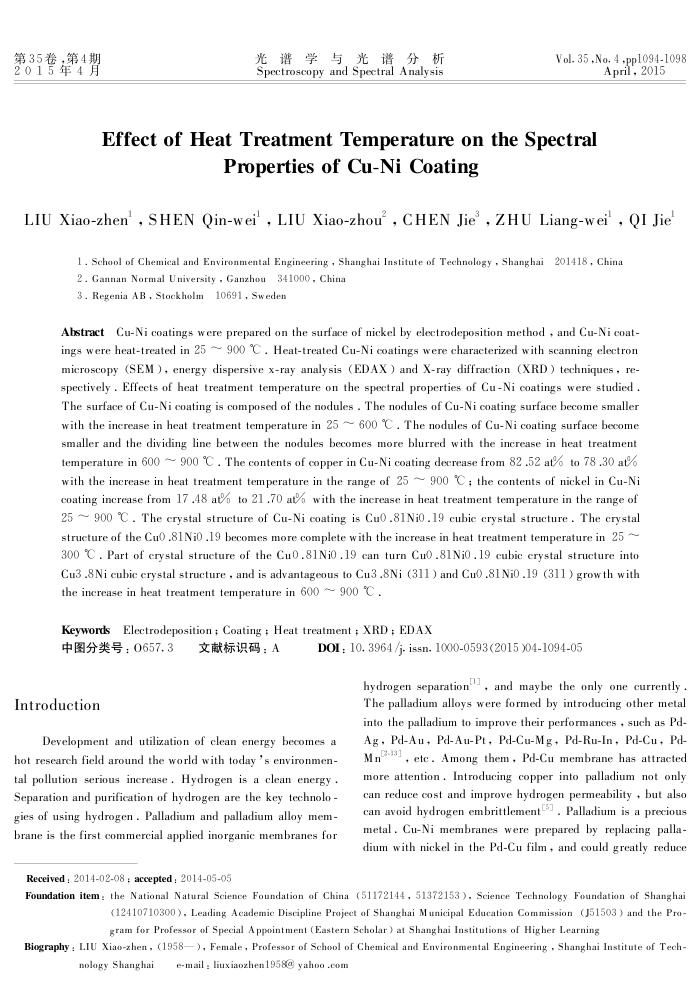您当前的位置:首页>论文资料>热处理温度对铜镍镀层的光谱性能的影响
内容简介
 第35卷,第4期 2015年4月
第35卷,第4期 2015年4月光谱学与光谱分析 Spectroscopy and Spectral Analysis
Vol.35,No. 4-pp1094-1098
April,2015
Effect of Heat Treatment Temperature on the Spectral
Properties of Cu-Ni Coating
LIUXiao-zhen',SHEN Qin-wei',LIU Xiao-zhou,CHEN Jie",ZHU Liang-wei',QI Jie
1. School of Chemical and Environmental Engineering , Shanghai Institute of Technology , Shanghai 201418, China
2. Gannan Normal University , Ganzhou 341000, China 3. Regenia AB, Stockholm10691, Sweden
Abstract Cu-Ni coatings were prepared on the surface of nickel by electrodeposition method , and Cu-Ni coat-ings were heat-treated in 25 ~~ 900 C . Heat-treated Cu-Ni coatings were characterized with scanning electron microscopy (SEM ), energy dispersive x-ray analysis (EDAX) and X-ray diffraction (XRD) techniques , re spectively . Effects of heat treatment temperature on the spectral properties of Cu-Ni coatings were studied , The surface of Cu-Ni coating is composed of the nodules . The nodules of Cu-Ni coating surface become smaller with the increase in heat treatment temperature in 25 ~~ 600 C . The nodules of Cu-Ni coating surface become smaller and the dividing line between the nodules becomes more blurred with the increase in heat treatment temperature in 600 ~~ 900 C . The contents of copper in Cu-Ni coating decrease from 82 .52 at% to 78 .30 at% with the increase in heat treatment temperature in the range of 25 900 C ; the contents of nickel in Cu-Ni coating increase from 17.48 at% to 21 .70 at% with the increase in heat treatment temperature in the range of 25 ~ 900 ℃ . The crystal structure of Cu-Ni coating is Cu0 .81Ni0.19 cubie crystal structure . The crystal structure of the CuO .81Nio .19 becomes more complete with the increase in heat treatment temperature in 25 ~ 300 C . Part of crystal structure of the Cu0.81Nio.19 can turn Cu0 .81Ni0.19 cubic crystal structure into Cu3.8Ni cubic crystal structure, and is advantageous to Cu3.8Ni (311) and Cuo .81Nio .19 (311) growth with 0060ganeadnaaasea
KeywordsElectrodeposition ; Coating ; Heat treatment ; XRD; EDAX
中图分类号:0657.3
Introduction
文献标识码:A
DOI: 10, 3964 /j. issn. 1000-0593(2015 )04-1094-05
hydrogen separation', and maybe the only one currently. The palladium alloys were formed by introducing other metal into the palladium to improve their performances , such as Pd-
Development and utilization of clean energy becomes a hot research field around the world with today's environmen-tal pollution serious increase . Hydrogen is a clean energy . Separation and purification of hydrogen are the key technolo -gies of using hydrogen . Palladium and palladium alloy mem-brane is the first commercial applied inorganic membranes for
Received : 2014-02-08 ; aceepted : 2014-05-05
Ag , Pd-Au, Pd-Au-Pt, Pd-Cu-Mg, Pd-Ru-In, Pd-Cu, Pd-Mn2-13], etc . Among them , Pd-Cu membrane has attracted more attention. Introducing copper into palladium not only can reduce cost and improve hydrogen permeability , but also can avoid hydrogen embrittlement(3] . Palladium is a precious metal . Cu-Ni membranes were prepared by replacing palla-dium with nickel in the Pd-Cu film , and could greatly reduce
Foundation item: the National Natural Science Foundation of China (51172144, 51372153 ), Science Technology Foundation of Shanghai
(12410710300 ), Leading Academic Discipline Project of Shanghai Municipal Education Commission (J51503 ) and the Pro gram for Professor of Special A ppointment (Eastern Scholar ) at Shanghai Institutions of Higher Learning
Biography : LIU Xiao-zhen , (1958—), Female , Professor of School of Chemical and Environmental Engineering , Shanghai Institute of Tech-
nology Shanghai
e-mail : liuxiaozhen1958@ yahoo .com